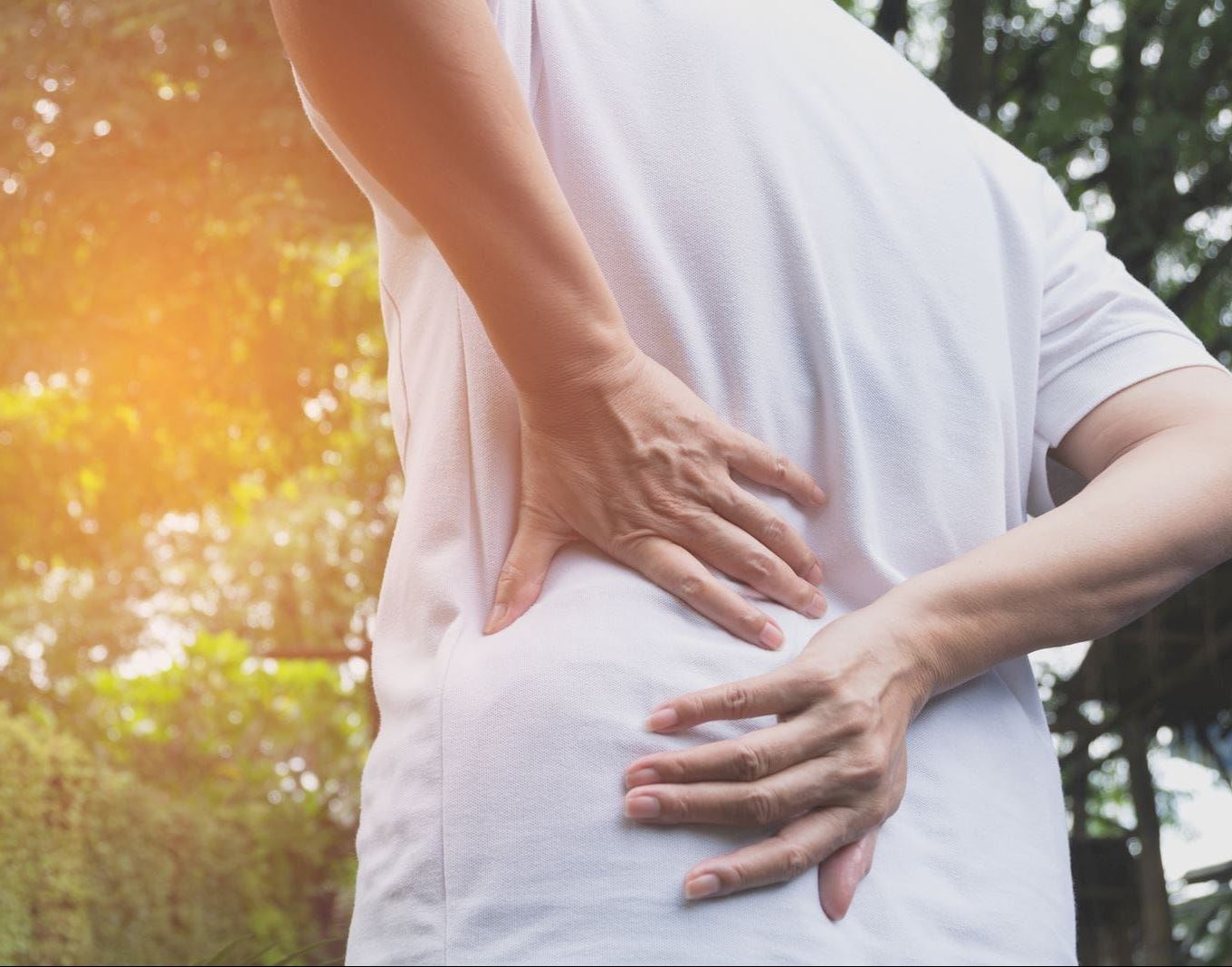Back pain can stop you in your tracks. And it can really strike anywhere — your upper (cervical) spine, your middle (thoracic) spine and your lower (lumbar) spine. Unfortunately, you’re not alone: Almost 80 percent of American adults report experiencing some sort of back pain in their lifetime. But why does back pain usually happen in the lower lumbar section?
That part of your spine supports a lot of your upper body weight. Resting between each bone of your back (known as vertebrae) sits a little cushion-like disk that acts as a shock absorber when you move. The inside of the disk is filled with a jelly-like fluid, while the protective outside layer is more rubbery. When that cushion stops doing its job, pain can start.
Get the details on spinal-disk pain.
Though this type of back pain is common, it doesn’t make it any less painful. Sensations can run the gamut from a pinch to radiating pain or a spasm. And there are a number of causes, some you can control and others you can’t. Age, physical activity, pregnancy, weight gain, occupational risks and even mental health conditions can play a part.
Bulging Disk in Back or Neck
A bulging disk can happen simply because of age. Those shock-absorbing disks between vertebrae can “deflate” over time from losing fluid that helps to cushion the bones. The outer edge of the disk then weakens, causing the inside part to “bulge” out. Think of it as a hamburger that’s too big for its bun. Strains, sprains and other pressure can lead to a bulging disk, too.
Herniated, Ruptured or Slipped Disk in Back or Neck
If spinal pressure worsens or the bulging disk continues to break down, you may end up with a herniated disk (also known as a ruptured or slipped disk). This means that the fluid inside the disk actually breaks out of the protective layer and can lead to pressure on the nerves found on your spine (“pinching” your nerve).
What are the common symptoms of bulging or herniated disks?
Pain caused by problems with your spinal disks shows up in your back, but can also impact your legs, neck, knees and ankles. Keep an eye out for any of the following signs:
- Back pain, whether consistent or ebbing and flowing, alerts you that something’s up. It may be made worse by standing for longer periods of time, coughing or sneezing, or even walking. Often, pain is described as sharp or burning.
- If you have a slipped disk in your neck, your pain will be more concentrated to your shoulder or arm. If it’s in your lower back, you’ll likely feel it more in your glutes, thigh, calf or maybe even down to your foot (known as sciatica).
- A muscle spasm, or cramp, can be jarring and catch you off-guard. This happens when your muscle contracts involuntarily and can’t relax again — it may even be visibly twitching or hard to the touch.
- Numbness or tingling in an arm or leg is common if there’s a pinched nerve.
- Your legs may feel weak and cause you to lose balance or stumble.
These symptoms could be indications of another condition, too. It’s important to talk with your provider to understand the scope of these symptoms and get a proper diagnosis.
What are diagnosis and treatment options for spinal-disk injuries?
Once you schedule an appointment with your provider, they will ask you questions about your health history and complete a physical exam. Depending on your pain and symptoms, you may have other diagnostic tests done, too.
- Though an x-ray doesn’t detect a herniated disk, it can help rule out other potential causes of your back pain.
- A CT scan composites a series of x-ray images together to give a cross-section view of your spine.
- To locate the ruptured disk and see what nerve may be affected, an MRI uses radio waves and a strong magnetic field to create a detailed image.
- For a clearer view into your spine, a myelogram may be used. Dye is injected in your spinal fluid before CT scan to show where pressure is impacting your nerves.
- Electromyography (EMG) inserts an electrode into different muscles to see their electrical activity at rest and active.
Once diagnosed, you and your provider can get started on the road to recovery.
Often, changing some movement or activity can help relieve symptoms in a few days. Physical therapy may help with stretches and positions to minimize the risk of reinjuring your back. Pain relievers, including over-the-counter (OTC) medications, cortisone injections or muscle relaxers, can also help with pain management.
Surgery may help when herniated-disk symptoms get worse.
Though most people with bulging or herniated disks don’t require surgery, there are a few options available if your pain is unmanageable, has lasted for longer than six weeks with treatment or you’ve begun experiencing changes to your bladder and bowel control.
During a discectomy or microdiscectomy, tiny pieces of your vertebrae, surrounding ligaments or injured disk may be removed to relieve pressure. Rarely, the entire injured disk is removed. If that’s the case, the resulting gap will be replaced with a piece of bone (either from your own pelvis or a donor).
7 Ways to Get (and Keep!) Your Back in Shape
Once you’re onto recovery from a slipped or ruptured disk, it’s important to ease back into activity slowly. When you’re ready to get moving, keep these tips in mind:
- Listen to your body and be aware of what actions set off any pain. Make slow, controlled movements and take your time with bending forward or lifting anything.
- Always stretch before any type of strenuous activity.
- Try working on your posture — slouching puts unnecessary strain on your back. Stand or sit up straight while pushing your shoulders back, keeping your abdomen in and flattening the curve in the small of your back.
- Wear comfortable, low-heeled shoes.
- Lift from the knees, and don’t lift things that are too heavy and cause you to strain.
- Keep your weight in check through proper nutrition and activity.
- Try a different sleeping position: Lay on your side, and bring your knees into a fetal position. This curled-up posture helps open up the joints in your backbone and relieve pressure.
Most people can get back to pain-free movement after a spinal-disk injury. Though the progress may be gradual, discomfort in your legs, neck or back will ease up usually within six weeks. And once you return to your normal activities, remember the above steps to minimize reinjury.


